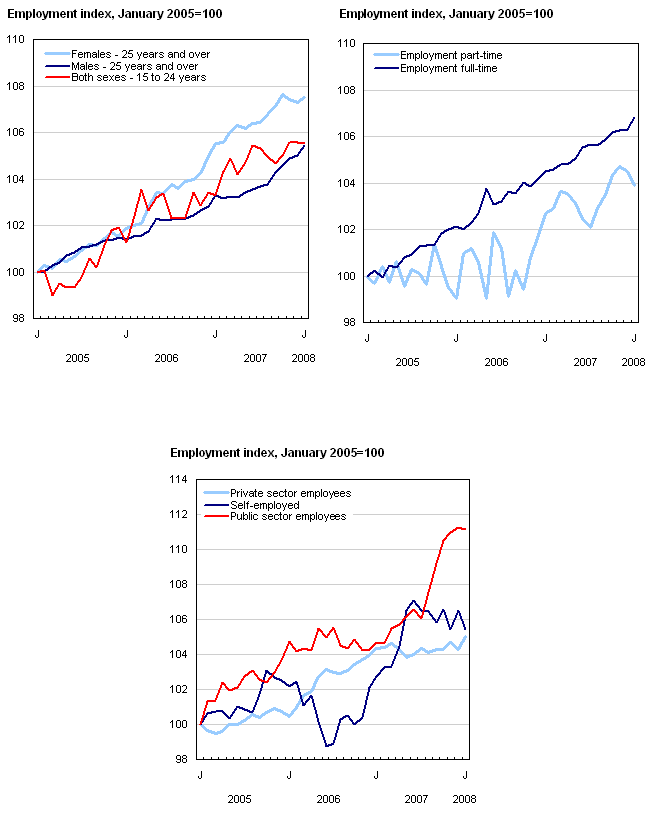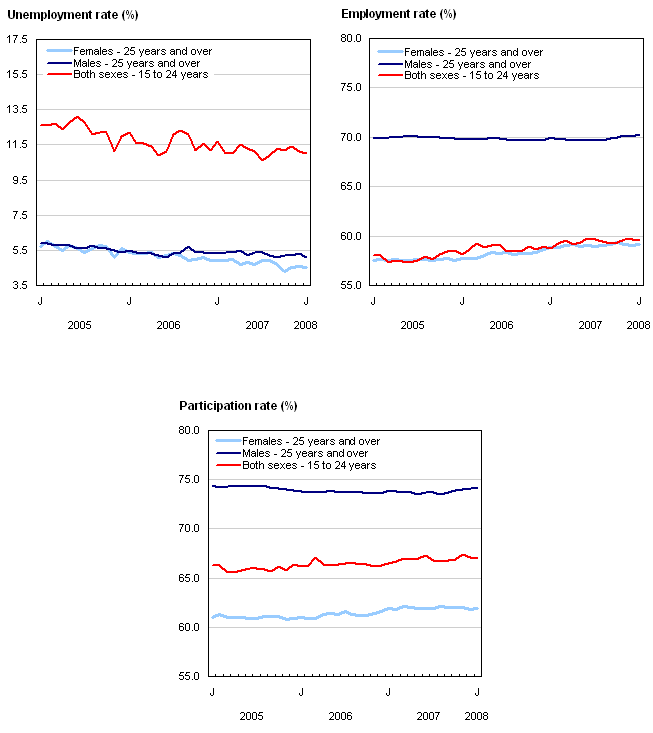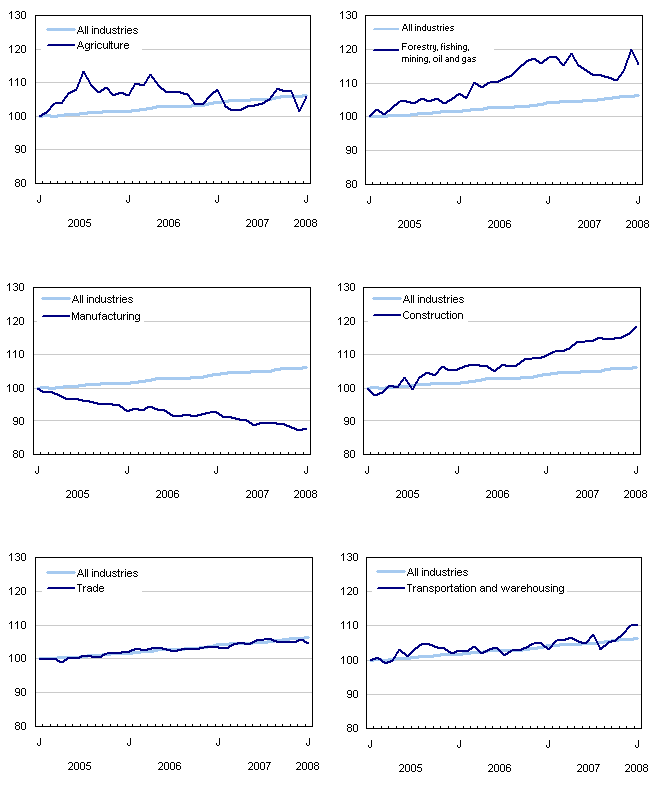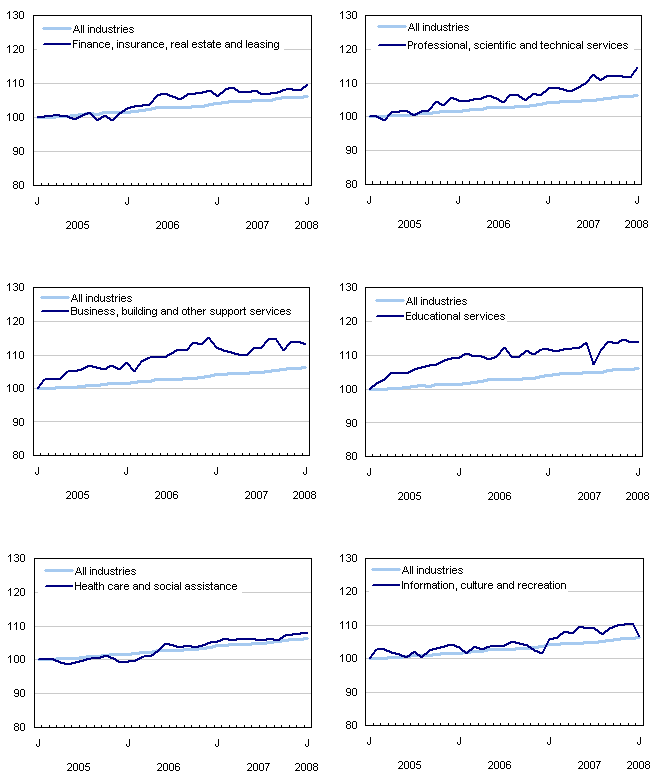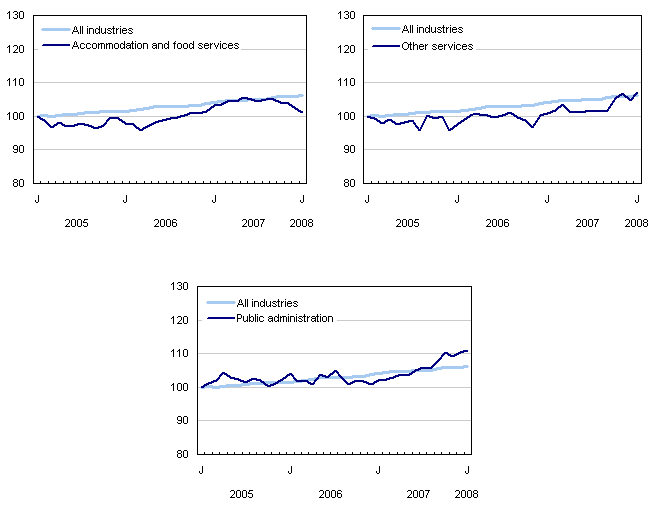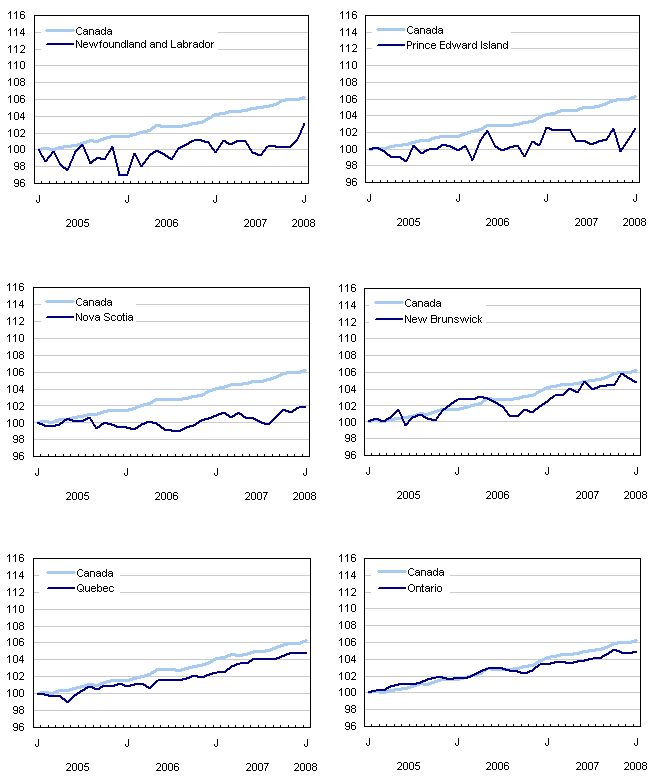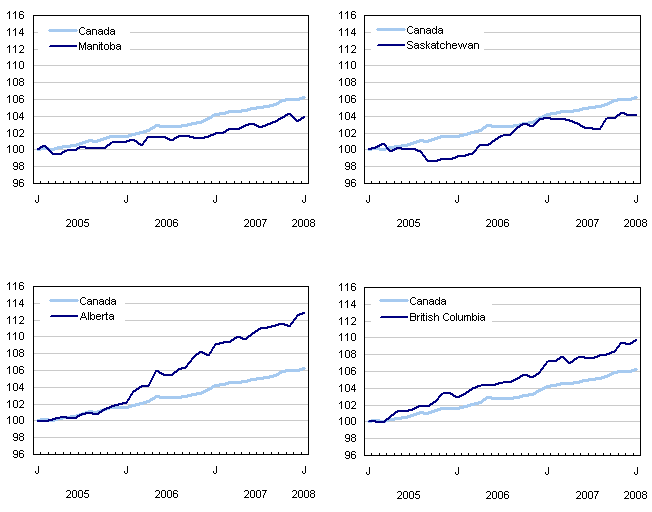Common menu bar links
Not for release before 7 A.M. E.S.T. Friday, February 8, 2008
January 13 to 19, 2008
Archived Content
Information identified as archived is provided for reference, research or recordkeeping purposes. It is not subject to the Government of Canada Web Standards and has not been altered or updated since it was archived. Please "contact us" to request a format other than those available.
Analysis — January 2008
Employment grew by an estimated 46,000 in January, boosting the employment rate to a record high (63.8%). These gains pushed the unemployment rate back down to 5.8%, matching the 33-year low also reported in October 2007.
With January’s gains, employment growth over the past twelve months was estimated at 337,000 (+2.0%).
Employment growth in January was wholly attributable to an increase in full time. Over the last 12 months, full-time work has grown at nearly double the rate of part time.
Gains in January were widespread across a number of industries, most notably in professional, scientific and technical services and in construction. Overall employment gains were tempered by decreases in information, culture and recreation as well as in retail and wholesale trade.
In January, the number of employees in the private sector jumped by 77,000. Despite this increase, the number of private sector employees was only 0.7% higher than a year earlier.
Employment increased in several provinces in January. Building on strong growth in recent months, Alberta, British Columbia and Newfoundland and Labrador attained record employment rates in January.
In Quebec, the unemployment rate fell to a 33-year low of 6.8% in January.
Wage growth remained vigorous in January, with a year-over-year increase in average hourly wages estimated at 4.9% for the second consecutive month. This was well above the most recent increase of 2.4% in consumer prices. January also marked the sixth consecutive month with a year-over-year increase in hourly wages at or above 4%.
Employment growth was spread across several sectors
Employment growth in January was spread across a number of industries in both the goods and service sectors.
In the goods-producing sector, gains were recorded in construction (+20,000); manufacturing (+18,000); agriculture (+14,000) and utilities (+6,000). Following an increase in December, employment in natural resources declined in January (-13,000) to a level similar to that of January 2007.
In the service sector in January, substantial increases were observed in professional, scientific and technical services (+30,000); finance, insurance, real estate and leasing (+16,000) and “other services” (+16,000). These gains were offset by declines in information, culture and recreation (-28,000) and trade (-27,000).
Over the past twelve months employment growth was strongest in construction; professional, scientific and technical services; public administration; transportation and warehousing and “other services”.
Although manufacturing employment edged up in January, over the past 12 months it was down by 113,000 (-5.4%), with most of the declines in Ontario and Quebec.
Public sector takes a breather
Public sector employment was unchanged in January for the third consecutive month. This pause follows sizeable gains, which pushed employment in this sector up an estimated 6.2% over the past 12 months. By comparison, self-employment grew 2.6% during the same period, while growth among private sector employees was a meagre 0.7%.
Labour market still robust in the West
British Columbia’s employment increase in January (+12,000), all in full time, was spread across several industries. In the past twelve months, British Columbia’s employment growth (+2.4%) was above that of the national average. The employment rate reached a record high of 63.9%.
Alberta’s still-flourishing labour market continued to beat records. January’s increase in employment, while slight, was enough to raise the province’s employment rate to a new record high (72.1%). In the past twelve months, employment gains have been strongest in trade; health care and social assistance and public administration.
Employment in Manitoba increased by an estimated 3,000 in January, pushing the unemployment rate down to 3.8%, its lowest level since June 2006. This was the second lowest rate in Canada, after Alberta (3.2%). Employment gains in Manitoba over the past 12 months (+2.0%) were entirely in full-time work.
In Ontario, a slight increase in employment brought the unemployment rate down 0.2 percentage points to 6.3% in January. Employment growth over the last twelve months (+1.5%) was below the national average, with gains in a number of service industries tempered by losses in manufacturing, as well as accommodation and food services. In January, accommodation and food services posted its fourth decline in as many months.
Quebec’s unemployment rate declined 0.2 percentage points to 6.8% in January, its lowest level in 33 years. While historically much higher than Ontario’s rate, Quebec’s unemployment rate has fallen substantially since August 2003. As a result, the gap between the unemployment rates for the two provinces has been less than one percentage point for nearly a year. In the past twelve months, the employment increase of 87,000 in Quebec (+2.3%) has been driven primarily by growth in construction; transportation and warehousing; and accommodation and food services.
Following modest growth in December, Newfoundland and Labrador added an estimated 4,000 workers in January. With this increase, the province attained a record employment rate of 52.5% for the month.
An aging labour force
In January, the largest employment gains were among women aged 55 and over (+20,000) and men 25 to 54 (+25,000).
In the past year, employment has increased ten times faster among older workers aged 55 and over (+8.0%) than among workers aged 25 to 54 (+0.8%). Older workers have captured a large share of employment gains, owing in part to the growth of this group within an aging Canadian population and in part to the steady rise in their employment rate since 1997.
Note to readers
The Labour Force Survey estimates are based on a sample, and are therefore subject to sampling variability. Estimates for smaller geographic areas or industries will have more variability. For an explanation of sampling variability of estimates, and how to use standard errors to assess this variability, consult the Data Quality section in this publication.
Seasonally adjusted estimates from the Labour Force Survey have been revised using the latest seasonal factors, going back three years (January 2005 onwards). They are now available on CANSIM (tables 282-0087 to 282-0094).
The 2006 Labour Force Historical Review on CD-ROM (71F0004XCB, $209) will be available February 19.
